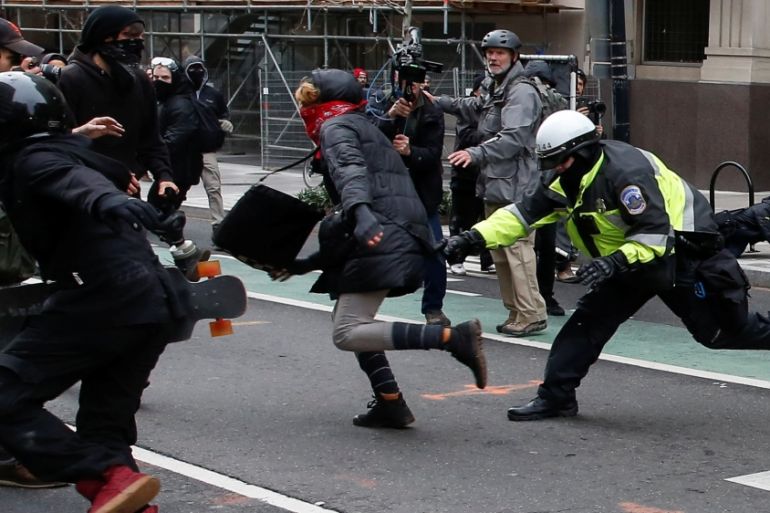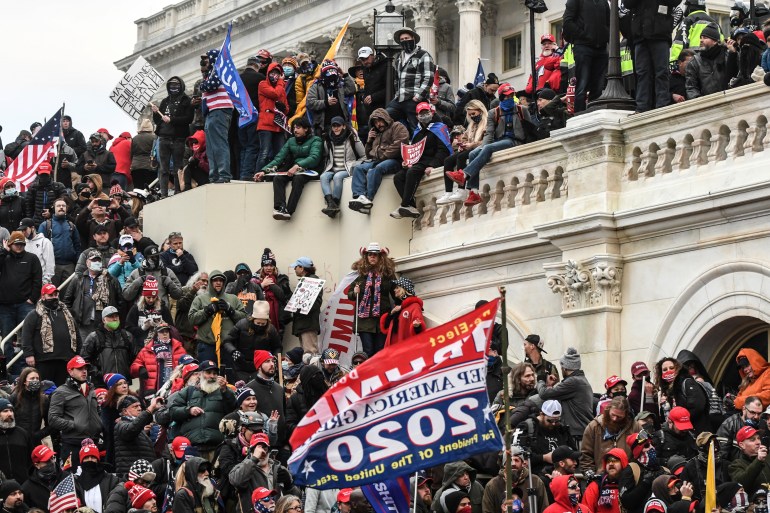Leaks show DC cops justify ‘aggressive’ protest tactics: Expert
DC police training presentation obtained by Al Jazeera depicts ‘increasingly violent’ left-wing protest movement.

Documents obtained by Al Jazeera appear to show Washington, DC’s Metropolitan Police Department (MPD) used a training document to justify “an aggressive police response” to left-wing demonstrations and legal observers, according to experts.
Ransomware group Babuk stole the documents from MPD several weeks ago and asked a bounty of $1m for their return. MPD did not pay, resulting in their leak.
Keep reading
list of 3 itemsDC police suffer ‘massive’ info leak after ransomware attack
How the far right got a stranglehold on the West
The documents include a January 2019 PowerPoint training presentation hacked from an MPD intelligence officer entitled “First Amendment Training Presentation”.
The majority of the presentation features images of myriad left-wing groups, causes and demonstrations, including Antifa, environmentalists, the Women’s March and more. There are also images of police in riot gear responding to these demonstrations.
It depicts a network of “Direct Action” movements that are becoming “[m]ore violent, less passive”, and is taking a more “violent focus towards” law enforcement.
“The content of this is what was typical in the late 1990s, early 2000s, as far as describing protest activity in a way that justifies an aggressive police response”, Michael German, a fellow with the nonpartisan Brennan Center for Justice’s Liberty and National Security Program and former FBI special agent, told Al Jazeera.
“Even the pictures they have are mostly pretty aggressive police responses, rather than recognising the vast majority of First Amendment demonstrations are entirely peaceful”, German said.
It is impossible to know what was said over the slides of the presentation. However, the notes featured on some of the slides offer portions of the intelligence officer’s point of view.
Antifa’s ‘moral compass’
On a slide labelled “Antifa”, the officer wrote: “This group by far is the most violent we have dealt with over the years. AS you all are aware during the Inauguration of President Trump this was the group the [sic] destroyed property, assaulted any Trump supporter they ran into to include the elderly.”
The text apparently refers to January 20, 2017, when DC saw widespread protests from various groups, including Antifa, a decentralised, amorphous group of far-left individuals known for violent altercations with far-right groups.

The day saw some property damage and violent confrontations between protesters. Hundreds of anti-Trump protesters were arrested and more than 200 people were charged, including independent journalists. Many faced up to 70 years in prison. The majority of these charges were dropped by July 2018.
“They have no moral compass on who they go after”, the slide says.
“I never was aware that law enforcement was supposed to determine the morality of a group, rather than whether they were breaking the law,” German said.
German also questioned the characterisation of Antifa as the “most violent” group. “I don’t think that’s empirically true … it’s certainly not based on any kind of empirical analysis.”
German concluded: “I think this training in 2019 would help to understand why the police response to the Black Lives Matter protests was so aggressive and violent, because they’re trained to believe that a First Amendment demonstration is a threat.”
Umbrella group
The slides also mention medics and legal observers as part of “Protest Umbrella Groups”. A slide entitled “Legal Observers” shows people wearing bright green hats, a hallmark of the National Lawyers Guild’s (NLG) legal observer programme.
The progamme is “designed to enable people to express their political views as fully as possible without unconstitutional disruption or interference by the police” during protests, according to the NLG’s website.

The slide appears to suggest legal observers are aware of impending illegal activity.
“In the past, just before an illegal activity is to occur, the observers appear and put on their caps”, the notes say.
“During the DNC in LA, I saw them put on their caps just before protesters began throwing rocks at the police”, the officer wrote in first person, the only time this occurs in the presentation.
The author appears to be referring to the 2000 Democratic National Convention in Las Vegas, which experienced protests that were sometimes violent.
Maggie Ellinger-Locke, chair of NLG Mass Defense Committee that oversees the legal observer programme, told Al Jazeera “learning about this is troubling, but it’s not surprising. There is a long history of law enforcement attacks against NLG.”

Ellinger-Locke explained legal observers observe police actions with people expressing their First Amendment rights, she explained.
“We are present merely to observe the protest, not participate in it ourselves”, Ellinger-Locke said. “I would suggest that this clearly misrepresents the role of the legal observer.”
Brian Levin, director of the Center for the Study of Hate and Extremism at California State University, San Bernardino, and former New York Police Department officer, was more forgiving.
“DC is a little bit of a different oasis, as far as extremism, or even public demonstrations,” Levin said. He noted Trump had been in power for two years at that point, during which time Republicans controlled Congress. As such, people were more likely to protest against right-wing Republican policies.
Left-wing protests were “what they were seeing on the ground”, Levin said. Also, that is where “intelligence gathering and dissemination went to during that last administration”.
Levin noted that agencies such as the Department of Homeland Security downplayed white nationalist threats, and MPD would likely have relied on those agencies for intelligence.
Still, it is difficult to consider the documents without reflecting on the events of January 6, 2021, when pro-Trump rioters attempted to stop a joint session of Congress from certifying President Joe Biden’s electoral victory.
Another set of leaked intelligence briefings from January 12 to 21 about a perceived threat of another Capitol insurrection raise questions about law enforcement’s familiarity with far-right and anti-government groups.
They focus on “Operation Stormbreaker”, described on January 19 as maps circulated by the Boogaloo Bois “that appear to show areas to target by priority, timeframes and teams” of the gun-wielding, anti-government group.
A January 20 briefing says it “appears the map did not originate from Telegram but came from an unknown QAnon channel” which was investigated by the FBI. No threat materialised.

Levin cautioned the leak did not provide full context for MPD’s training materials, but “looking a bit in the rearview mirror” it appears the police “didn’t avail themselves to the increasing threat being posed by the far right”.
By January 2019, white supremacists had killed an antiracist protester in Charlottesville, Virginia, and massacred 11 people at the Tree of Life Synagogue in Pittsburgh, Pennsylvania, among other acts of violence.
MPD did not respond to Al Jazeera’s request for comment.
Ellinger-Locke expressed a similar concern about the lack of focus on the far right.
“It’s not talking about white supremacists and I really think that that lays bare the bias that MPD has directed at people exercising their First Amendment rights”, Ellinger-Locke concluded.